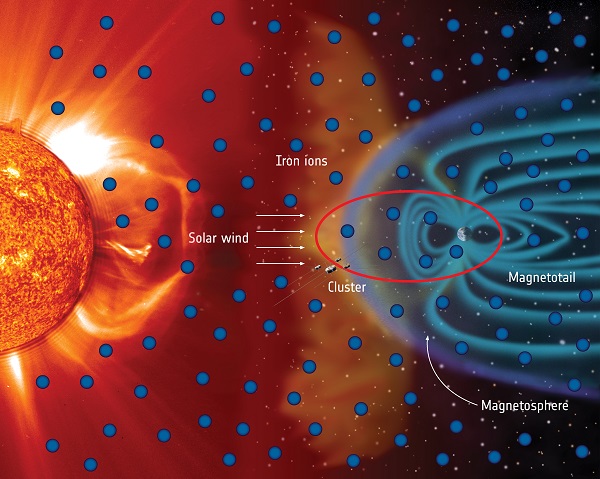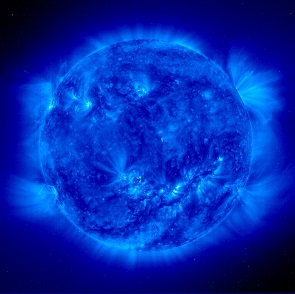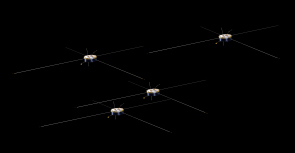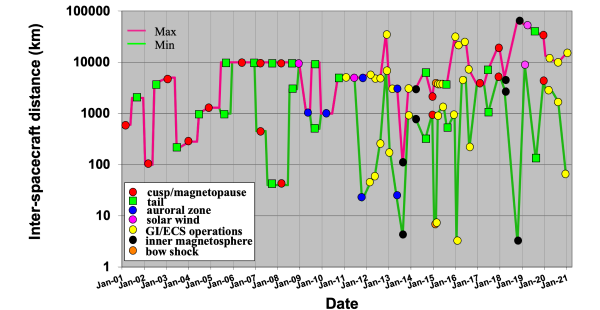Iron is everywhere in Earth's vicinity, suggest two decades of Cluster data
19 March 2020
Using over 18 years of data from ESA's Cluster mission, scientists have mapped the heavy metals in the space surrounding Earth, finding an unexpected distribution and prevalence of iron and shedding light on the composition of our cosmic environment. |
| Iron in the solar wind and Earth's magnetosphere. Credit: ESA; Sun: ESA/NASA/SOHO/LASCO/EIT |
Space is often presumed to be devoid of matter, but technically it is not really empty: the distribution of matter is just very, very sparse. In the vicinity of Earth, the space that scientists call 'geospace' is actually filled with charged particles: a mixture of electrons, which have negative charge, and positively charged ions. These ions are key players in the electrodynamics processes we see in geospace, and contribute to the turbulent, changeable nature of this part of the cosmos.
A surprising detection
A new study uses over 18 years of data from ESA's Cluster mission – launched in August 2000 and approaching its 20th anniversary in space – to explore the prevalence of an important ion thought to be relatively rare near Earth: iron. By delving into Cluster data gathered from 2001 to 2018, the researchers detected an unexpected distribution of iron throughout geospace.
"Although the amounts are tiny, we found iron everywhere: across the entire region of geospace covered by Cluster, and in the near-Earth solar wind – the continuous outpouring of charged particles from the Sun," says lead author Stein Haaland of the Max Planck Institute for Solar System Research in Göttingen, Germany, and the Birkeland Centre for Space Science at the University of Bergen, Norway.
"We detected iron in roughly 10% of the observations which, given the relative rarity of the ion, is surprising. We didn't expect to find it so often."
However, it is not the presence of iron itself that is surprising, but rather its properties. The JAXA/NASA Geotail satellite, which has spent over 25 years observing Earth's magnetic environment, had detected singly-ionised iron in geospace in 2017. These are atoms of iron that have been stripped only of the most external of their electrons. The new results not only confirm this finding, but provide an essential new part of the picture.
"The Cluster observations focus on a far higher energy range than Geotail, and give us a more complete view of the space around us, detecting not only singly-ionised iron but also multiply-ionised iron – these are ions in higher energetic states which have been stripped of more than one electron," adds Stein. "Iron in the solar wind tends to be seen in higher charge states, so we need this wider, higher energy range to understand the solar wind in particular and its impact on Earth's magnetic environment."
The source of iron in geospace
 |
| Active regions and magnetic loops on the Sun, seen in ultraviolet. Credit: ESA/NASA - SOHO/EIT |
Ions can enter geospace from above or below. Some travel up from Earth's atmosphere, while others stream in from the solar wind. The source of heavy metals, such as iron, is still debated – where do these ions come from, and how do they contribute to the phenomena we see around us?
"The Geotail observations focused on iron moving up from Earth's atmosphere, and at rather low energies," explains Stein. "We found that there is much more iron coming from the Sun, and at far higher energies. We also found iron in the regions above Earth's polar caps – a location that Geotail did not cover."
Building upon previous results, the new study explores the potential source of the ionised iron in more depth. This is a key factor in understanding the dynamics and properties of geospace, our magnetosphere, the solar wind, and how these structures meet and interact.
Previous research has proposed that detections of iron ions at higher latitudes may be due to a variety of factors, including meteorites entering Earth's atmosphere and breaking up, particles being elevated from certain layers of the atmosphere, or even particles being ejected from the Moon. However, the new Cluster results do not show convincing evidence of any of these processes; instead, they suggest that the iron comes straight from the Sun.
"The data on iron distribution and presence varied over time in a way that matched up with disturbances in Earth's magnetic field, and long-term fluctuations in solar activity," says Stein. "This suggests that the most of the iron in geospace originated from solar wind that passed through the magnetosphere, rather than traveling upwards from our planet's atmosphere."
Hidden in the data
 |
| Artist's impression of the Cluster spacecraft. Credit: ESA/ATG medialab |
To map the composition of geospace, Stein and colleagues used Cluster data in an unexpected way. They exploited measurements that were gathered not for scientific purposes, but for operational diagnostics of one of the spacecraft's instruments – RAPID (Research with Adaptive Particle Imaging Detectors).
The instrument identifies and characterises the various ions it detects by measuring their energies and travel time inside the detector. For the ordinary scientific activity, RAPID calculates these properties only for hydrogen, helium and oxygen atoms; however, for diagnostic purposes, the instrument provides additional properties for a limited number of particles, extending the probed range to heavier ions.
These measurements serve to calibrate the instrument and ensure that it is functioning as intended. However, the scientists used these diagnostic observations – a total of 122 000 hours – to determine the composition of incoming ions and identify iron particles.
"RAPID's ability to measure ion composition was essential. We need composition measurements to help us better understand where the various elements found on or near Earth come from, and to characterise our cosmic environment," says Stein.
Mining the archives
Understanding the space surrounding Earth is one of Cluster's core objectives. The quartet of spacecraft, flying in formation around Earth, has spent years passing in and out of our planet's magnetic field, investigating how the Sun and Earth interact and characterising the phenomena caused by these interactions.
The mission's longevity and its wide orbit have enabled it to gather nearly two decades of data covering all near-Earth regions of space, and large parts of the solar wind.
 |
| Distance between the Cluster spacecraft during the mission |
"We needed this long timespan for our research – and this was only possible thanks to the Cluster Science Archive, which provides best-quality data for the scientific community to use," adds co-author Patrick Daly, also of the Max Planck Institute for Solar System Research and Principal Investigator of the RAPID instrument.
"It took considerable effort to set up this archive, and to continually maintain its very high standards of calibration and reliability. The archive is a credit to the numerous dedicated engineers, spacecraft operators and data archiving teams that have ensured that Cluster remains operational and still provides new, exciting, accessible information about near-Earth space."
Notably, the datasets in the Cluster Science Archive include detailed diagnostic data – something that is not usually included in all mission archives.
"This highlights the importance of science archives in general and diagnostic data in particular, showing how really valuable information can be gleaned from these versatile datasets in order to produce cutting-edge scientific results," says Philippe Escoubet, ESA Cluster Project Scientist.
"It also nicely demonstrates how research continually evolves and pushes forward. Detecting iron would have been a totally unexpected result back when Cluster first launched, but the mission continues to provide a treasure trove of data about Earth's environment."
Notes for editors
"Suprathermal Fe in the Earth's plasma environment: Cluster RAPID observations" by S. Haaland et al. (2020) is published in the Journal of Geophysical Research: Space Physics.
The Cluster Science Archive can be found at the following link: https://csa.esac.esa.int
For further information, please contact:
Stein Haaland
Max Planck Institute for Solar System Research
Göttingen, Germany
Birkeland Centre for Space Science
University of Bergen, Norway
Email: Stein.Haaland![]() uib.no
uib.no
Patrick Daly
Max Planck Institute for Solar System Research
Göttingen, Germany
Email: daly![]() mps.mpg.de
mps.mpg.de
Philippe Escoubet
Cluster Project Scientist
European Space Agency
Email: Philippe.Escoubet![]() esa.int
esa.int




